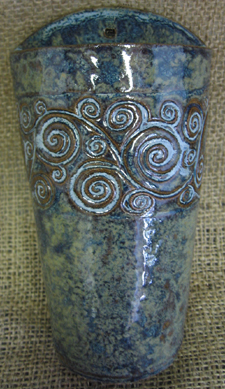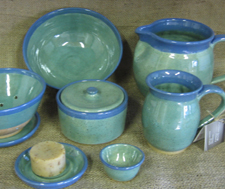 |
||||
| Home | Gallery | Process | Shows | |
| I
talk to a lot of pottery lovers throughout the year. Some of them took a
course in high school or tried throwing a pot at summer camp. Many of
them want to give it another try. I always encourage them to go for it.
Making pottery is a joy.
And a process. A process that requires patience. Just like the rest of us - a pot has a journey to go on - from a ball of clay to a mug that will hold your morning coffee. I use three distinctly different stoneware clays. One is a white clay that is smooth, feels good to throw but has a tendency to flop if you work with it too long. The thing I love about it is that the glaze colors are brighter and you can do magical things on this white clay with colored slip. Slip is watered down clay to which I add stains and end up with a watery, colored clay that I brush over a paper shape. When the slip is dry I remove the piece of paper, fire the piece, cover it with a clear glaze and fire it again (remember the long journey). That is how I made the buttons shown here. I use the same technique for ornaments and some pots. My second clay is a gray stoneware that I drive four hours (from Pennsylvania to Massachusetts) to buy in the Berkshires. It is a grittier clay that holds together well for wide bowls and makes great wall pockets. Many glazes don't look good on this clay because it is too dark. But I put layers of other glazes on with wonderful drippy results. Wonderful when they stay on the pots. Not quite as wonderful when they drip onto the kiln shelf and require a chisel for removal. That is part of my journey - figuring out how to get those wonderful drippy glazes to stay on the pots. My third clay starts out brown (a yummy chocolate brown), is pink after the bisque (first) firing and ends up a speckled buff color after the second firing. |
|
You can see this clay in the bottom photograph - a lot of turquoise pots. As you can see, the colors are bright on this clay also. In many pottery courses you start out learning how to hand build pots with pinching and coiling. Those are both wonderful and fun techniques suitable for all ages. The results can be quite sophisticated. Usually those techniques are followed by working with rolled out slabs of clay. Eventually you get to throw pots on the wheel - a skill that requires bursts of strength and periods of relaxation. And practice. Maybe I am regressing but slab building has become one of my favorite ways to work with clay. I cut out pieces, add textures to them and put them back together into wall pockets, sponge holders, soap dishes.... And tiles... tiles that get cut up and reassembled into mosaics or attached to flower pots. Tiles that get one hole in them and become an ornament or a pendant for a necklace. Tiles that get two holes in them and become a button. Tiles that become the center piece for a mosaic coaster. Tiles that become pins, barrettes, magnets... A few more process details. I fire my stoneware in an electric kiln to around 2200 degrees F. It becomes very durable and food-safe. I put all of the pots I use in the dishwasher, microwave and oven. Thanks for visiting! Bebe Do you have questions? Email me
|
||

|
||||

